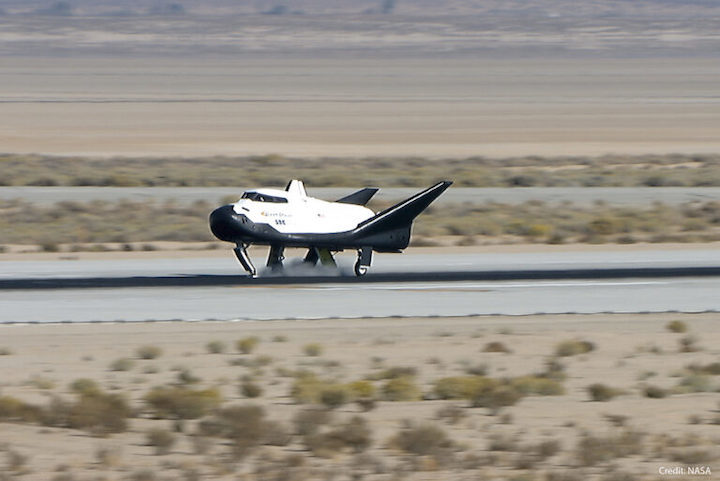11.01.2020

Dream Chaser landing after free-flight test (dropped from a helicopter), November 11, 2017. Credit: Sierra Nevada Corporation.
Sierra Nevada Corporation (SNC) is on track for the first cargo flight of its Dream Chaser spacecraft next year. Looking like a small space shuttle, Dream Chaser lost out on a contract for NASA’s commercial crew program, but was selected in the second round of commercial cargo contracts. SNC still plans to use Dream Chaser for crewed missions for other customers and expects the first within 5 years. SNC also is bidding on contracts for NASA’s Artemis program, including as part of a Dynetics team for the Human Landing System.
Steve Lindsey, a former NASA astronaut who is now SNC’s Senior Vice President of Strategy for Space Systems, and other SNC officials gave updates on Dream Chaser and other space activities during a media telecon today.
SNC has “never stopped working” on the crewed version of Dream Chaser, Lindsey said. While the company’s focus right now is getting the cargo version ready for its first flight on a United Launch Alliance (ULA) Vulcan-Centaur rocket next year, the first crewed flight “absolutely” will take place within 5 years.
“There’s interest, not necessarily from NASA, but other customers” that Lindsey expects to grow once the cargo version is flying. SNC will offer either a “taxi model” where it supplies the crew to fly it, or a “rental car model” where the customer provides the crew. It will be up to the customer to decide.
In its cargo version, Dream Chaser will be outfitted with Shooting Star modules. SNC has big plans for both Dream Chaser and Shooting Star for other missions in Earth orbit and beyond, including as part of NASA’s Artemis program. SNC also is developing a 27-foot diameter three-level inflatable habitat, Large Inflatable Fabric Environment (LIFE), that could be used in lunar orbit, for transit to Mars, or on the lunar or Martian surface, Lindsey said.
Dream Chaser is far from SNC’s only space program. The company has participated in more than 450 civil, commercial and national security space missions, including many of NASA’s robotic space probes. Currently it is providing subsystems or components for the Mars 2020 rover, the Europa Clipper mission to Jupiter’s moon Europa, the Lucy mission to study Jupiter’s Trojan asteroids, and the Double Asteroid Redirection Test (DART).
NASA selected SNC as one of five new contractors for its robotic Commercial Lunar Robotic Services (CLPS) program in November. Under CLPS, contractors must build and launch a lunar lander. NASA provides only payloads to put on the lander, and money. NASA puts out task orders on which the contractors can bid. Lindsey and SNC Vice President of Business Development for Space Systems John Roth said the company is looking at those opportunities and deciding where to bid. Their lander concept is “pretty far along” and they are considering bidding for “probably most” of the four CLPS procurements NASA is planning this year, including VIPER, although NASA has delayed that procurement for now.
Roth also revealed that SNC is part of a team led by Dynetics that submitted a proposal for NASA’s Human Landing System (HLS). “We are on a team led by Dynetics Corporation,” he said, but could not share details.
Only two companies, Boeing and a Blue Origin team, have publicly announced that they sent in HLS proposals. Dynetics makes a third. It is widely expected that SpaceX also submitted a proposal, but the company has not confirmed it.
Janet Kavandi recently joined SNC as Senior Vice President of Space Exploration Systems. A former NASA astronaut, she had been Director of NASA’s Glenn Research Center. She said today that she joined SNC because of Dream Chaser, the “safest and most logical solution to commercial spaceflight” since it can land on “thousands of runways” around the world. She made three space shuttle flights, the last (STS-104) with Lindsey.
Dream Chaser is a lifting body design based on work NASA was doing decades ago for a spaceplane called HL-20 to deliver passengers and cargo to an Earth-orbiting space station.
SNC was one of three competitors for the final phase of the commercial crew program, but SpaceX and Boeing won those contracts in 2014. It protested the award, but the protest was denied by the Government Accountability Office. It then decided to offer an uncrewed version for the second round of NASA’s Commercial Resupply Services (CRS-2) contracts. SpaceX and Orbital ATK (now part of Northrop Grumman) also bid on CRS-2. All three won contracts for at least six missions each.
Quelle: SPACEPOLICYONLINE.COM
